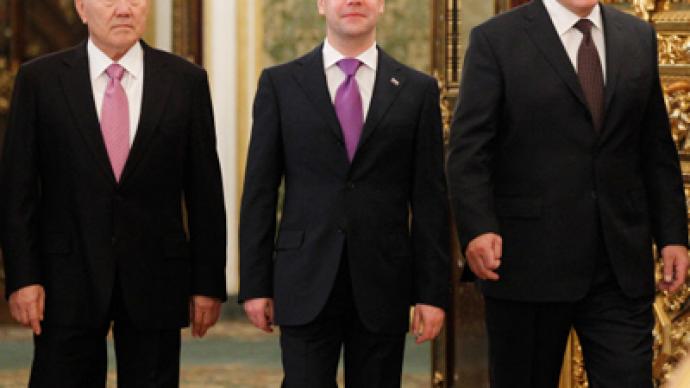Eurasian Union: Stage 1

The leaders of three member-states of the Customs Union have signed an agreement on further integration. Writer and political scientist Igor Panarin believes that November 18, 2011, marks the beginning of the Eurasian Union.
In the article below, Panarin explains his view. I am happy that the idea of the Eurasian Union, voiced by Vladimir Putin on October 3, 2011, is quickly taking shape. In two weeks’ time, on October 18, 2011, the CIS countries set up a free-trade zone. And just a month later, on November 18, the presidents of Russia, Belarus and Kazakhstan signed a Declaration on Eurasian Economic Integration. It’s the so-called “roadmap” of the integration process, with an ultimate goal of establishing the Eurasian Economic Union.The countries have taken an unprecedented decision to create the Eurasian Economic Commission, a supranational body that will be in charge of all integration processes. It is set to become the first supranational body since the collapse of the USSR that will gradually take over powers from each of the countries. It means that we will soon have, just like the Europeans, officials doing the job of EU commissioners, a move that will certainly please Brussels. The decade-long experience of European integration is pivotal for us, in as much as the positive achievements of the Soviet period in Russia’s history.Apparently, the Eurasian integration will be a difficult road. We may see attempts by the national elites of the newly independent states to resist the process. To avoid possible clashes of interests, the member-states have established clear-cut decision-making regulations for the Eurasian Economic Commission that are supposed to rule out domination of any state in the new entity. The EEC will be a two-level body, with the Commission Council uniting deputy prime ministers and the Commission College, a working body to which member-states will delegate their representatives in the capacity of international independent officials.Essentially, we are witnessing the beginning of the Eurasian Union, the founding of a single economic space based on the regulations and principles of the WTO. This reveals ample opportunities for Ukraine’s EU-2 accession. Ukraine explained its refusal to join the Customs Union by saying it would contradict WTO regulations. That is why the chances of Ukraine’s EU-2 accession will grow after the Moscow summit. It would be good to see Ukraine join the Common Economic Space as soon as the end of 2012.What is important is that the Common Economic Space will be open to all nations, not just former USSR states, during the initial stages of its creation. Let me remind you that New Zealand (yes I am referring to the Pacific island that produces a lot of meat) recently showed interest in joining the Customs Union.The Customs Union, currently comprised of Belarus, Kazakhstan and Russia, is in full force. Work is currently in progress to improve mechanisms for trade within the union and its legislative framework. There is some progress: total trade between the three countries grew by 40 per cent in the first six months of 2011. New Zealand’s interest is clearly justified.Some politicians and experts say that that even some Latin American nations like Cuba and Venezuela may join the EU-2 in the future. The prospect was discussed at the November 16 roundtable in the State Duma. It might sound like something out of a novel today, far more so than my own idea about Serbia joining, but we are living in very dynamic times, especially considering that the foundation for the EU-2 has already been laid at the summit of the leaders of the Custom Union states on November 18 in Moscow.
Professor Igor Panarin, Doctor of Political Sciences, for RT
The statements, views and opinions expressed in this article are solely those of the author and do not necessarily represent those of RT.












